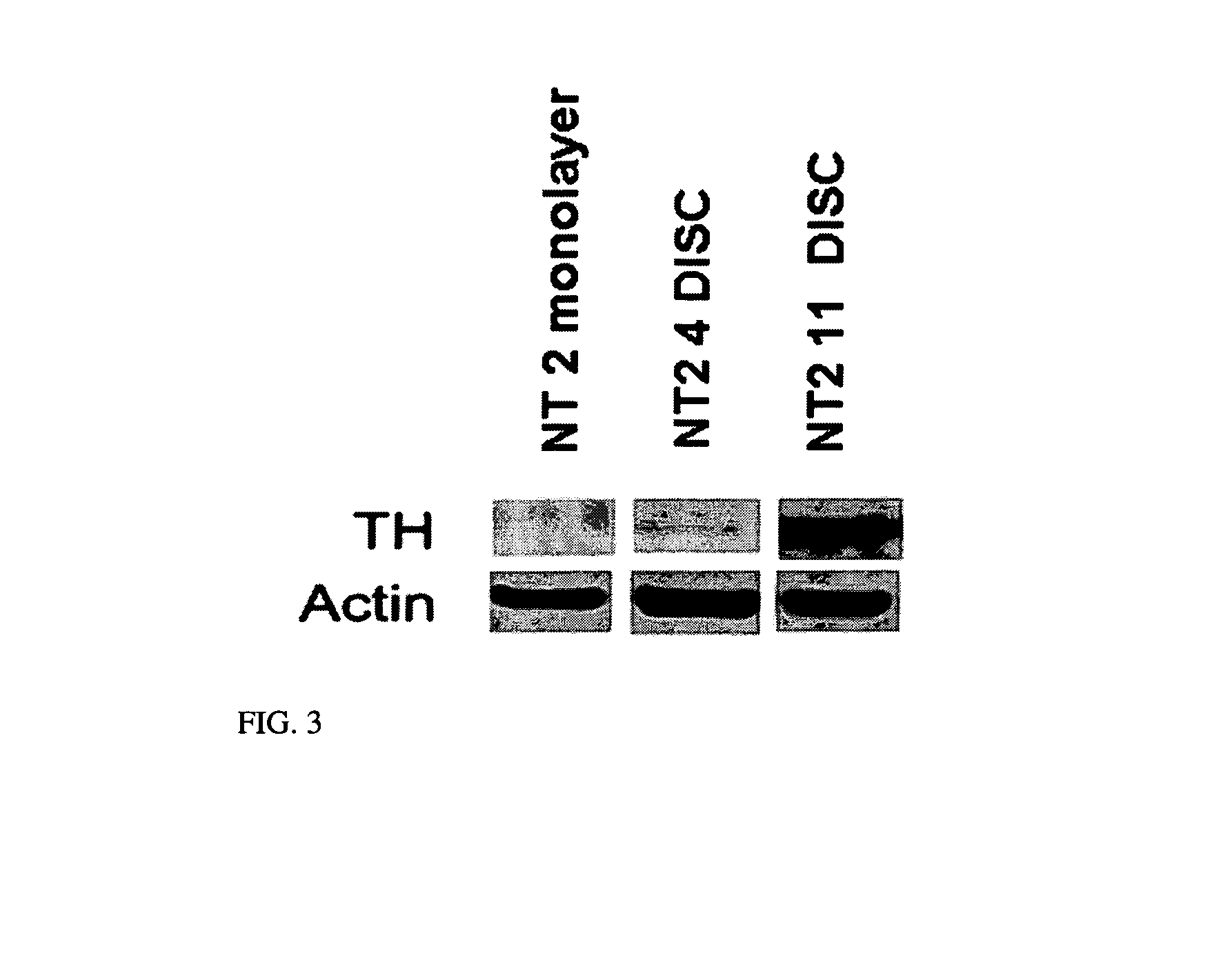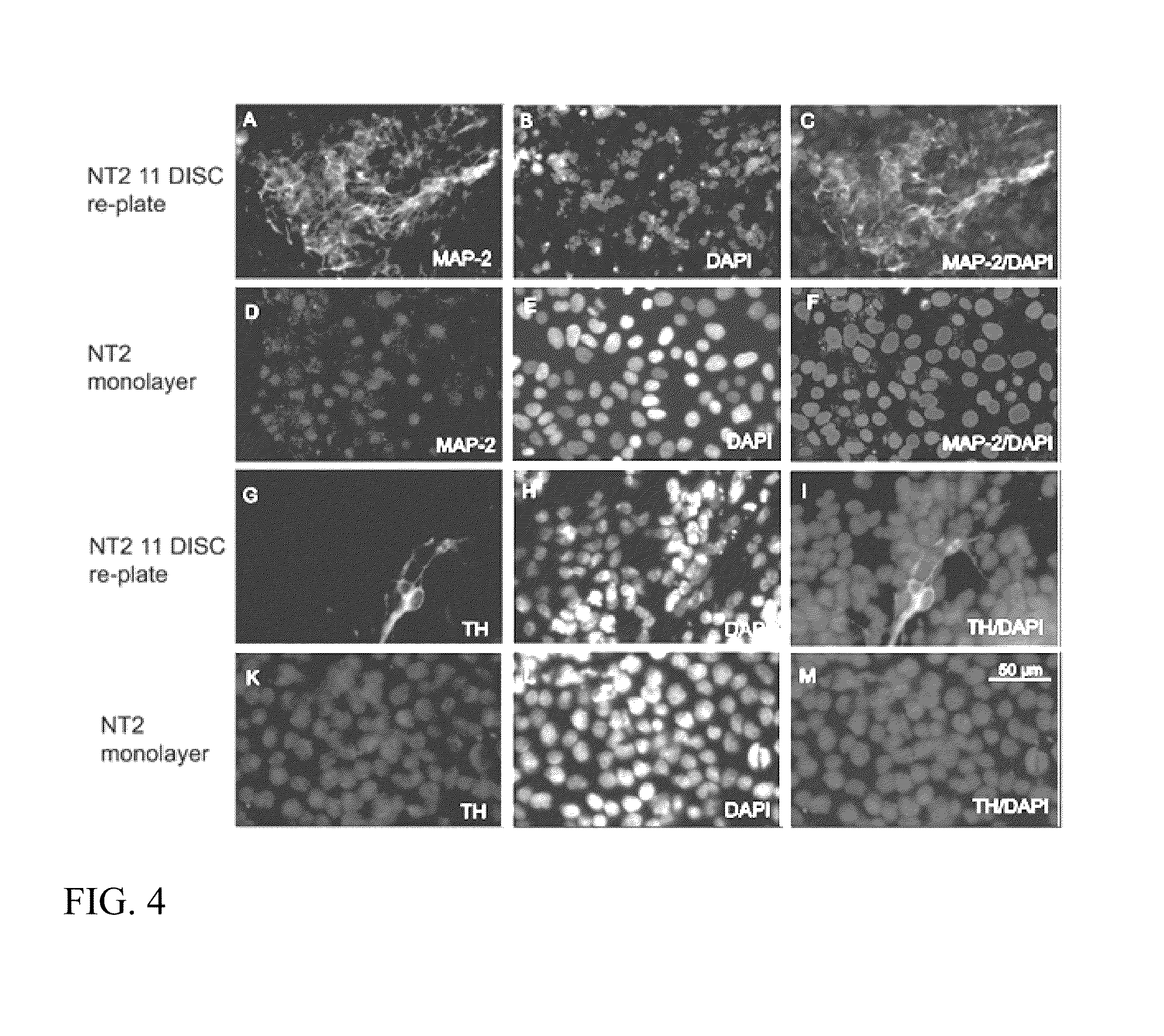Stable differentiation of NT2 cells
a technology of nt2 cells and differentiation, which is applied in the direction of embryonic cells, artificial cell constructs, biochemistry apparatus and processes, etc., can solve the problems of unstable differentiation of daughter cells created following stem cell division, insufficient determination of appropriate concentration and time of delivery of known growth factors, and inability to know if all appropriate growth factors for a given stem cell have been identified, etc., to achieve stable dopaminergic phenotype
- Summary
- Abstract
- Description
- Claims
- Application Information
AI Technical Summary
Benefits of technology
Problems solved by technology
Method used
Image
Examples
example 1
Differentiated NT2N Neurons Derived from Aggregated NT2 Cells not Exposed to Retinoic Acid Survive and Engraft in the Rat Striatum
[0071]Results
[0072]FIGS. 1 through 4 show that NT2 spheres differentiate to dopaminergic neurons without retinoic acid. FIGS. 5 and 6 show that NT2 spheres survive in the host striatum and retain their dopaminergic phenotype. FIGS. 7 through 11 show possible signaling pathways for NT2 differentiation. The results demonstrate that there is an increase in the expression of TH in NT2N neurons within NT2 spheres grown in 3-dimensional suspension culture after 4 DISC without retinoic acid treatment, compared to NT2 cells grown in monolayer conventional culture. TH expression is markedly increased in re-plated 11 DISC NT2 spheres together with expression of multiple neuronal markers such as MAP-2 and synaptophysin. There is also increased unphosphorylated β-catenin in NT2 spheres, with almost no change in GSK-3β, and a marked decrease in N-cadherin, compared to...
example 2
Human NT2-N Neurons Differentiated by the Cell Aggregation Method have Functional Neurotransmitter Systems In Vitro
[0096]The NTera2 / cloneD1 (NT2) human teratocarcinoma cell line is capable of terminal differentiation into postmitotic neurons (NT2N) upon exposure to retinoic acid (RA). These NT2N differentiated with RA (hNT) are a heterogeneous population of neurons expressing multiple neurotransmitter enzymes. hNT neurons harvested and analyzed with High Performance Liquid Chromatography (HPLC) have low but detectable levels of dopamine (DA) present, while NT2 cells do not. Further supporting the in vitro functionality of these neurons, excitatory glutamatergic and inhibitory gamma-aminobutyric acidergic (GABAergic) are formed when hNT neurons are plated on primary astrocytes. However, hNT neurons lose expression of neurotransmitter enzymes after 30 days in vitro and in vivo, indicating loss of phenotype and a probable loss of functionality.
[0097]We have developed an alternate metho...
example 3
Material and Methods for the Examples 4-7
[0111]NTera2 / D1 cells:
[0112]The NTera2 / D1 (NT2; ATCC) were thawed quickly at 37° C. until just before the last ice crystals were gone. The cells were gently transferred to a 15 cc centrifuge tube filled with 10 ml of Dulbecco's Modified Eagle's Medium (DMEM:F12), 10% fetal bovine serum (FBS) and 0.1% gentamycin (Sigma). The cells were centrifuged at 700 rpm for 7 min, the supernatant discarded, and the cells re-suspended in 1 ml of the DMEM: F12 / FBS media. Viability and cell number were assessed using the trypan blue dye exclusion method.
[0113]Formation of NT2 Spheres:
[0114]The NT2 cells were gently transferred to a 15 ml centrifuge tube containing 10 ml of DMEM, 10% FBS and 0.1% gentamycin, centrifuged at 700 rpm for 7 min and re-suspended in 1 ml of the DMEM / FBS media. NT2 precursors were seeded at 1×107 cells / 50 ml in 150 mm plates in the same medium as described and subcultured when they achieved 70-80% confluence. The cells were lifted u...
PUM
| Property | Measurement | Unit |
|---|---|---|
| temperature | aaaaa | aaaaa |
| internal diameter | aaaaa | aaaaa |
| pressure | aaaaa | aaaaa |
Abstract
Description
Claims
Application Information
 Login to view more
Login to view more - R&D Engineer
- R&D Manager
- IP Professional
- Industry Leading Data Capabilities
- Powerful AI technology
- Patent DNA Extraction
Browse by: Latest US Patents, China's latest patents, Technical Efficacy Thesaurus, Application Domain, Technology Topic.
© 2024 PatSnap. All rights reserved.Legal|Privacy policy|Modern Slavery Act Transparency Statement|Sitemap



